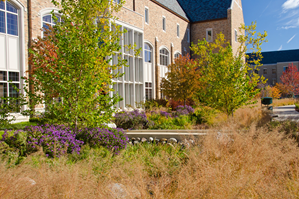
A team of civil engineering majors has taken on the Environmental Protection Agency’s first ever Campus RainWorks Challenge. In this challenge, the EPA asked college students from across the country to design innovative green infrastructure projects for their campus to tackle storm water runoff issues.
Notre Dame’s team designed two ways to address campus storm water: building rain gardens around residence halls and academic buildings, and installing vegetated bioswales, also called filter strips, along the edges of campus parking lots. The team consisted of Eily Andruszkiewicz ’14, Emily Palmer ’14, Claire Sieradzki ’14, Will Connors ’14, Amanda Shockling ’15, and Matthew Matasci ’16.
“In addition to the rain gardens providing a location for native plants to grow, they would also slow the velocity of storm water falling off of the buildings and therefore cause less erosion,” explained Andruszkiewicz. “The rain gardens would also allow storm water to infiltrate the soil and recharge groundwater supplies.” The proposed bioswales would reduce the velocity of storm water runoff, and help remove harmful chemicals that accumulate on the surface of parking lots from cars.
“The team did very thorough research and presented their results very professionally,” commented Rob Nerenberg, Associate Professor of Civil and Environmental Engineering, who advised the project. “What impressed me the most is that this project was entirely the students’ initiative: they took responsibility for every aspect of the project and did a lot in a very short amount of time.”
The team agreed that building awareness for the issues associated with storm water runoff is very important. “We decided to design something that is by no means revolutionary, but that would make people more aware of storm water management issues if implemented,” said Connors.
“The most difficult part was finding a balance between an innovative and feasible solution,” said Matasci. The costs of implementing and maintaining these solutions reduce the practicality of the project, but this problem could be minimized if they win the competition. The winning teams, announced in April, will receive a cash prize as well as research funds for their faculty advisor to conduct research on the potential of green infrastructure to sustainably manage storm water. “We are very proud of how it came together and hope that the University will take a look at our final project and consider implementing some of our proposed solutions,” added Shockling.